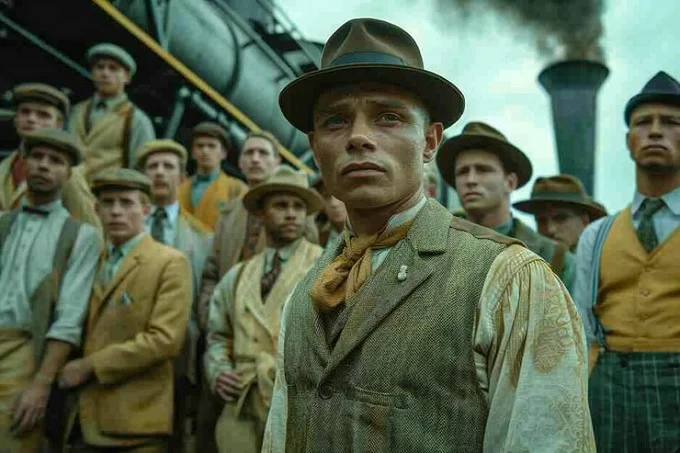Have you ever watched a historical movie and felt like you were right there, living through those moments? That’s the magic of cinema, but it’s also something more specific – it’s what we call the Oppenheimer Effect. This fascinating concept has been shaping how we see history on the big screen, and it’s more important than you might think.
In this article, we’re going to dive deep into the Oppenheimer Effect. We’ll explore what it is, where it came from, and how it’s changing the way we experience historical films. Whether you’re a movie buff or just curious about how history is portrayed in pop culture, this is something you’ll want to know about.
So, grab some popcorn and get comfortable. We’re about to embark on a journey through time, cinema, and the incredible impact of one man’s legacy on how we understand our past.
Understanding the Oppenheimer Effect
What is the Oppenheimer Effect?
The Oppenheimer Effect is a term used to describe how historical films can shape our understanding of past events. It’s named after J. Robert Oppenheimer, the famous physicist who played a key role in developing the atomic bomb during World War II.
But why Oppenheimer? Well, it’s because his story perfectly illustrates how complex historical figures and events can be simplified and dramatized for the big screen. The effect is all about how movies can make history more accessible and engaging, but sometimes at the cost of nuance and accuracy.
The Historical Context
To really get the Oppenheimer Effect, we need to take a quick trip back in time. Picture this: it’s the 1940s, the world is at war, and a group of brilliant scientists are working on a top-secret project that will change the course of history.
This was the Manhattan Project, led by our man, J. Robert Oppenheimer. He and his team were racing to build the world’s first atomic bomb. It was a time of intense pressure, moral dilemmas, and world-changing decisions.
J. Robert Oppenheimer: The Man Behind the Effect
So, who was Oppenheimer? He wasn’t just any scientist. He was a theoretical physicist who became known as the “father of the atomic bomb”. But he was also a complex person with doubts and regrets about his work.
After seeing the destruction caused by the bombs dropped on Hiroshima and Nagasaki, Oppenheimer famously quoted a line from Hindu scripture: “Now I am become Death, the destroyer of worlds.” This quote captures the moral weight of his work and has become a powerful symbol in how we think about the atomic age.
It’s this complexity – the brilliant scientist, the moral dilemma, the world-changing impact – that makes Oppenheimer’s story so compelling for filmmakers. And that’s where the Oppenheimer Effect comes in.
The Oppenheimer Effect in Film Industry
How Does It Work?
The Oppenheimer Effect is all about how movies can take complex historical events and turn them into compelling stories. Here’s how it typically plays out:
- Simplification: Historical events are often incredibly complex. Movies need to simplify these events to fit into a 2-3 hour runtime.
- Dramatization: To keep audiences engaged, filmmakers often amp up the drama. This might mean exaggerating conflicts or creating composite characters.
- Personalization: Big historical events are often told through the eyes of one or a few key figures. This helps the audience connect emotionally with the story.
- Visual Impact: Films can recreate historical settings and events in vivid detail, making history feel more immediate and real.
Examples in Action
Let’s look at some movies that show the Oppenheimer Effect in action:
- “Oppenheimer” (2023): Christopher Nolan’s recent film is a perfect example. It takes the complex story of the Manhattan Project and focuses it through the lens of Oppenheimer’s personal journey.
- “The Imitation Game” (2014): This film tells the story of Alan Turing and the breaking of the Enigma code. It simplifies the complex work of codebreaking and focuses on Turing’s personal struggles.
- “Hidden Figures” (2016): This movie brings to light the untold story of African American women mathematicians who worked at NASA during the Space Race. It personalizes a big historical moment through the experiences of a few key figures.
In each of these cases, we see how the Oppenheimer Effect works to make history more accessible and engaging for modern audiences.
Case Studies: The Oppenheimer Effect in Action
Let’s dive deeper into some specific examples to really understand how the Oppenheimer Effect shapes historical films.
Case Study 1: “Oppenheimer” (2023)
Christopher Nolan’s “Oppenheimer” is perhaps the most literal example of the Oppenheimer Effect. Here’s how it plays out:
- Simplification: The film condenses years of complex scientific work and political maneuvering into a three-hour movie.
- Dramatization: It heightens the tension between Oppenheimer and Lewis Strauss, played by Robert Downey Jr., to create a central conflict.
- Personalization: The movie tells the story of the atomic bomb through Oppenheimer’s personal journey and moral struggles.
- Visual Impact: Nolan recreates the Trinity test – the first detonation of a nuclear weapon – in stunning visual detail.
The film has been praised for its historical accuracy in many areas, but it still employs the Oppenheimer Effect to make the story more cinematic and engaging.
Case Study 2: “The Imitation Game” (2014)
This film about Alan Turing and the breaking of the Enigma code during World War II is another great example:
- Simplification: The complex process of codebreaking is simplified into a more straightforward narrative.
- Dramatization: The film creates additional conflicts and tension that may not have existed in real life.
- Personalization: It focuses heavily on Turing’s personal life and struggles, using them as a lens to view the larger historical events.
- Visual Impact: The recreation of Bletchley Park and the Enigma machine brings this piece of history to life.
While the film takes some liberties with historical accuracy, it succeeds in bringing Turing’s story and the importance of his work to a wide audience.
Case Study 3: “Hidden Figures” (2016)
This film about African American women mathematicians at NASA during the Space Race shows how the Oppenheimer Effect can be used to highlight overlooked historical figures:
- Simplification: The film condenses the stories of several women into three main characters.
- Dramatization: It creates dramatic moments, like Katherine Johnson running across the NASA campus to use the “colored” restroom, which didn’t happen exactly as shown.
- Personalization: By focusing on these three women, the film makes the larger story of the Space Race more relatable.
- Visual Impact: The recreation of 1960s NASA and the space launches brings this era to vivid life.
While not 100% historically accurate, the film succeeds in bringing attention to these previously unsung heroes of the Space Race.
The Impact of the Oppenheimer Effect on Audience Perception
So, how does all this movie magic affect how we understand history? It’s a bit of a double-edged sword.
On one hand, the Oppenheimer Effect makes history more accessible and engaging. It can spark interest in historical events and figures that people might otherwise never learn about. After watching “Oppenheimer”, you might be inspired to read more about the Manhattan Project. Or after “Hidden Figures”, you might want to learn more about the contributions of women and people of color to the space program.
On the other hand, there’s a risk that people might take these dramatized versions of history as 100% fact. It’s important to remember that while these films are based on true events, they’re still movies, not documentaries.
The key is to use these films as a starting point for learning about history, not the end point. They can be a great way to get people interested in historical events and figures. But for a full understanding, it’s always good to follow up with some reading or documentary watching.
Criticisms and Controversies
Not everyone is a fan of the Oppenheimer Effect. Some historians and critics argue that it oversimplifies complex events and can lead to misunderstandings about history.
There’s also concern about how these films choose which stories to tell. Whose perspectives are being shown, and whose are being left out? This is an ongoing conversation in the film industry and among historians.
Despite these criticisms, many argue that the benefits of making history more accessible and engaging outweigh the drawbacks, as long as viewers understand that these films are dramatizations, not strict historical records.
Conclusion
The Oppenheimer Effect is a powerful tool in the world of historical films. It helps bring the past to life, making complex events and figures more accessible and engaging for modern audiences. From “Oppenheimer” to “Hidden Figures”, we’ve seen how this effect can shape our understanding of history.
But remember, while these films can be a great starting point for learning about history, they’re not the whole story. They’re meant to entertain and inspire, not to replace history books.
So the next time you watch a historical film, enjoy the drama and the spectacle. Let it spark your curiosity. But also take a moment to think about the real people and events behind the story. That’s the true power of the Oppenheimer Effect – it can open the door to a deeper understanding of our past.



